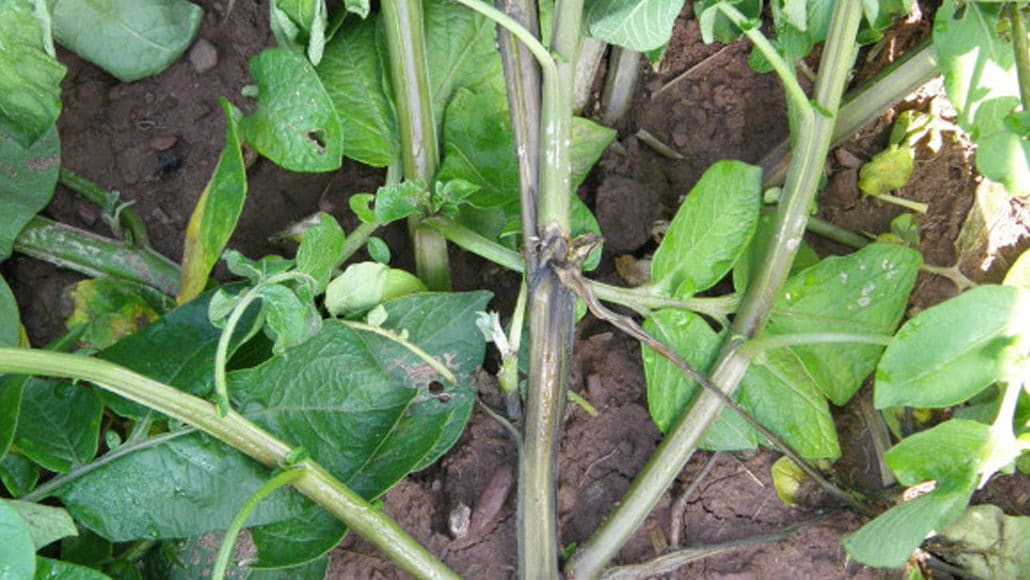A little-understood bacteria is bringing back an older potato disease and threatening the reputation of Maine seed potatoes, which farmers up and down the U.S. East Coast buy to grow their own spuds.
Since last summer, Tim Hobbs, the Maine Potato Board’s director of development and grower relations, has been spending a lot of his time on Dickeya, a bacteria that was responsible for an outbreak of the potato disease blackleg in the Mid-Atlantic region last year.
“For some individuals, it was quite bad,” Hobbs said of the blackleg, which leads to rot in the potatoes. Some farmers in Pennsylvania and Maryland growing Maine seed potatoes lost as much as half their crop.
Blackleg is caused by a number of bacteria, but the disease has been kept under control in Maine seed farms for well over a decade, making its emergence in the south a bit of mystery until the cause was identified as Dickeya by Steve Johnson, a crops specialist with the University of Maine Cooperative Extension in Presque Isle.
“This isn’t your daddy’s blackleg,” he warned farmers at the Maine Potato Conference in January.
Dickeya species have been a problem for European potato growers for decades, and the less noxious of them, Dickeya dianthicola, has been in the U.S. living among ornamental plants since the 1950s and recently started transitioning to potatoes and other crops, according to Hobbs.
For the first time in Hobb’s memory, last year the Maine Potato Board asked the Department of Agriculture, Conservation and Forestry to note the presence of blackleg in their field surveys of seed lots and include the findings in their North American Certified Seed Potato Health Certificate.
Eighty-three per cent of seed lots had no blackleg symptoms last year, and about eight percent of had more than a quarter of a percent of the disease, Hobbs said. But “there’s isn’t a seed supplier that I know of that’s willing to sign a guarantee that they don’t have Dickeya in their crop.”
The potato board is asking the Department of Agriculture to note blackleg symptoms again this year and to do three readings during the summer. Dickeya symptoms include non-emergence of potatoes, blackened stems and wilting plants. But sometimes Dickeya and other diseases can be difficult to detect or dormant, Hobbs said. “Depending on who you are, you might say, ‘Well, when did they go and how hard did they look?’”
The potato board also is offering seed growers free dormant and storage potato tests — to expose a potential “Typhoid Mary,” or a hidden source of the bacteria, according to executive director Don Flannery at the board’s last meeting.
Seed growers will have to pay more attention to overall sanitation, Johnson said. “If growers start with seed free from blackleg contamination,” he noted, “the disease can be kept at very low levels.”
Seed potatoes can be treated with fungicides, planted in soil that is not too wet and in fields that are regularly rotated between potatoes and other crops.
The Maine Potato Board also is considering the possibility of setting a tolerance threshold for its presence in seed certification, as is done for viruses. “We don’t want to set it too high or too low,” Hobbs said.
The trouble with Dickeya is it may not be symptomatic in Maine’s cooler climate, but when the potatoes are planted in the Mid-Atlantic fields, the environment may let the bacteria thrive and disrupt farmers’ rotation plans, Hobbs said.
Dickeya can only survive in the soil three months, but it can survive for more than a year on debris from corn — a common rotation crop with potatoes in the Mid-Atlantic — as well as on brassicas, the family of cruciferous vegetables and canola, Hobbs said.
“That’s something that our customers are asking about, because a lot of the places we’re selling to use corn as a rotation,” he said. “How do we get rid of this bacteria? Can you rotate out of it? Well, it depends.”
While the emergence of Dickeya has put a lot of pressure on the Maine Potato Board to help protect the quality of a key agricultural export, Hobbs said they are lucky no potato growers in North America are dealing with Dickeya solani, the more active species of the bacteria found in Europe that causes huge crop losses and is grounds for a quarantine.
“But we’re not under any illusion that it could never get here,” Hobbs said.
To learn more, visit Bangor Daily News.











